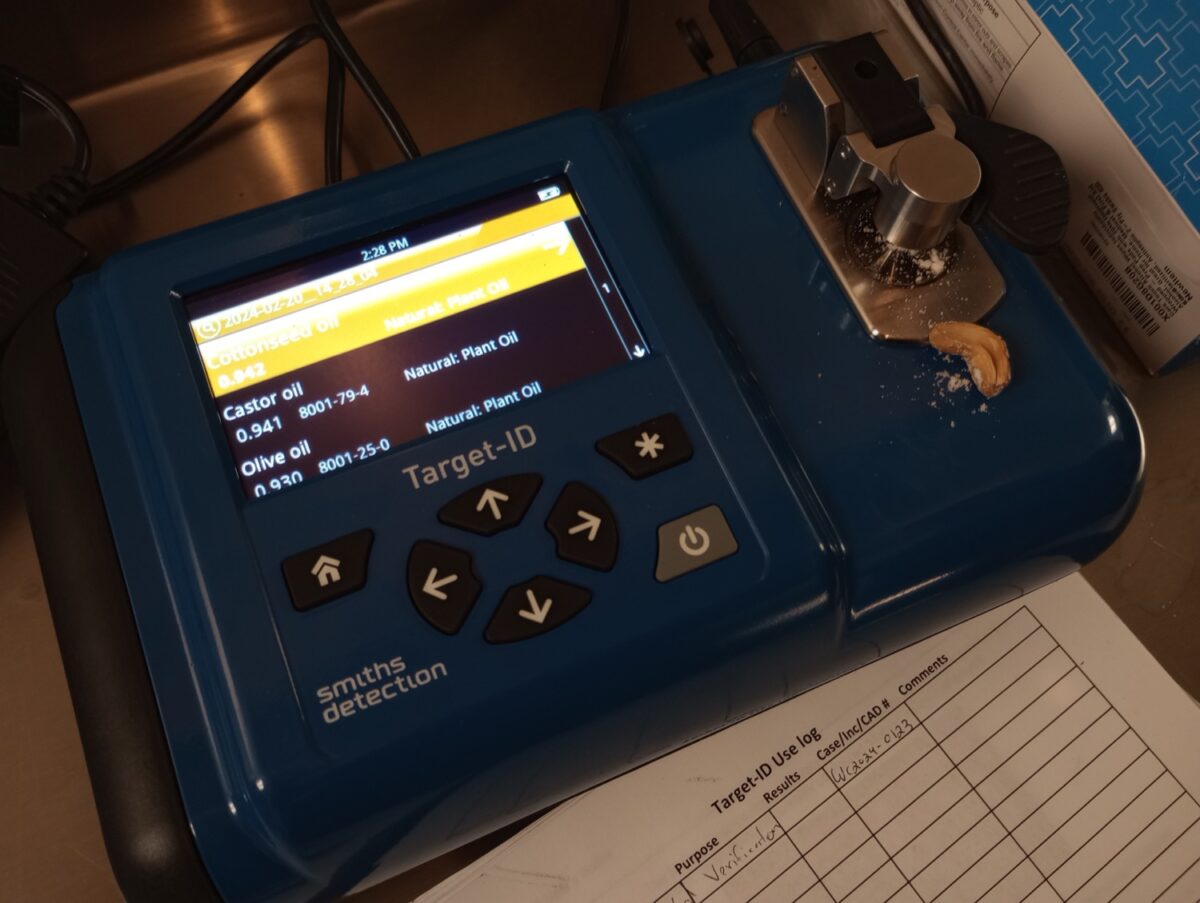Light passed into crumbs from the crushed cashew covering the small diamond sensor.
Within a minute, the Target-ID from Smiths Detection identified the cashew’s composition. The top three ingredients listed on the display were cottonseed oil, castor oil and olive oil.
The demonstration inside the Wayne County Sheriff’s Office evidence area showed how Target-ID could identify the substances comprising illicit drugs. It quickly identifies the drug and enables comparisons of samples’ ingredients.
Target-ID is one of two drug identification machines recently acquired by the sheriff’s department through a $102,000 Rural Violent Crime Reduction Initiative grant that required no local match. The sheriff’s department easily drew the connection between drug use and violent crime to receive the Department of Justice money through the private group administering the grant, said Major Alan Moore.
An Ionscan 600 sits near the jail’s body scanner for use during inmate intake. The Ionscan uses heat to read small litmus paper swabs wiped across surfaces to pick up trace particles. Within 10 seconds of sliding a swab into the reader, a display will identify any drug particles the swab procured.
Moore said the new equipment became attractive because three officers overdosed within an eight-month period when encountering suspicious powders during the jail inmate booking process. The equipment reduces contamination risk, even when protective equipment such as gloves and masks are worn.
In one instance, Moore said, officers were told the powder inside a case was crushed pills. Within 15 minutes, an officer overdosed.
“I watched the video of it, and talk about something terrifying to watch is one of your own people going down in an overdose,” Moore said.
Breathing airborne drug particles is the primary accidental exposure concern, Moore said.
Powders generally are not absorbed through the skin to cause overdoses, even with potent narcotics such as fentanyl, according to research; however, the National Institute for Occupational Safety and Health recommends emergency responders take precautions. Among those are not touching the eyes, nose or mouth; not eating, drinking or smoking; and not using hand sanitizer, which increases exposure. Cuts or scrapes also allow powder to penetrate through the skin.
With the Ionscan, officers do not open containers; instead, they swab the outside of the container to detect traces. Once the Ionscan identifies the specific drug, doctors know the best treatment avenue if a problem occurs.
In the jail, bunks, doorknobs and more can be swabbed to detect what substances have been present. Despite the body scanner, which was installed in December 2019, inmates still sneak — or receive — substances in the jail. Moore said “a lot” of individuals booked at the jail have a substance on them.
“People are so creative in hiding things,” Moore said.
If a substance is located, Target-ID matches it to a library of 2,500 substances, indicating the substance recipe, including the narcotic, precursors, common chemicals and cutting agents. That enables officers to connect substances through their recipes.
Moore gave the example of substances in two cells sharing the exact same ingredients. Uncovering the origin of one substance would also likely explain the second. On the street, that information is also valuable in locating a common source and establishing a link with a provider.
Officers have previously used liquid drug-identification kits to obtain presumptive IDs. The substances are then sent to the Indiana State Police laboratory for confirmation. That’s a monthslong process. The new equipment provides nearly instantaneous and thorough identification, although samples will still be sent to the laboratory.
The sheriff’s department can customize and update Target-ID’s library with new substances found locally. Moore said the department is also working with Smiths Detection to develop a database of results for quick comparisons, and the grant includes consultants helping the department use data to reduce violent crime.
With its simplicity, Moore said officers are encouraged to take advantage of Target-ID and build that database.
“Why not test everything?” he said.
A version of this article appeared in the March 6 2024 print edition of the Western Wayne News.

